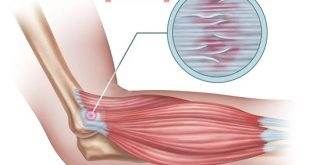What are Neurocutaneous Syndromes? Neurocutaneous syndromes is the term used for a group of rare neurological disorders that affect the brain, spinal cord, organs, skin, bones and peripheral nerve. Present at birth (congenital), these disorders are chronic, lifelong conditions. Each disorder has different symptoms, and can include tumors, hearing loss, …
Read More »Tendinopathy – Stages, Pathophysiology, and Treatment
Overview Tendinopathy is the broad term for any tendon condition that causes pain and swelling. Your tendons are rope-like tissues in your body that attach muscle to bone. When your muscles tighten and relax, your tendons and bones move. One example of a tendon is your Achilles tendon, which attaches your calf muscle to …
Read More »Vocal Cord Nodules – Causes, Risk Factors, and Prevention
What are Vocal Cord Nodules? Vocal cord nodules (referred to as “vocal fold” nodules by physicians) are growths that form on the vocal cords. These bumps are benign (non-cancerous) and are similar to calluses that can form on the hands. Nodules affect girls and boys of any age, and are …
Read More »Wells Syndrome or Eosinophilic Cellulitis – Overview and Causes
Definition Wells syndrome or Eosinophilic cellulitis is an acute, rare dermatosis of unknown etiology. Eosinophilic cellulitis is reported infrequently in children and is manifested by eosinophil infiltration in the dermis. Eosinophilic cellulitis presents with sudden onset of single or multiple mildly painful or pruritic, erythematous plaques. The lesions are usually …
Read More »Childhood Obesity – Risk Factors, Complications, and Prevention
Overview Childhood obesity is a complex disease that can occur when your child is above a healthy weight for their age and height. The medical definition of childhood obesity is having a body mass index (BMI) at or above the 95th percentile on the Centers for Disease Control and Prevention’s …
Read More »Livedo Reticularis – Types, Symptoms, and Complications
Definition Livedo reticularis (LR) is a common vascular reaction pattern characterized by a reticular (net-like) discoloration on the extremities and trunk. It is caused by decreased blood flow to the skin or impaired outflow in the dermal venous plexus and stagnation of the blood within these vessels. The darker, discolored …
Read More »Toxic Stress – Causes, Effects, Risk Factors, and Prevention
What is toxic stress? Toxic stress refers to prolonged, traumatic life events that occur for an extended period of time in the child’s life without the protection of an adult. Examples can include abuse (physical, sexual, emotional), neglect (physical, emotional) and household dysfunction (parental mental illness, domestic violence, parental incarceration). …
Read More »Hemiplegia – Types, Causes and Treatment
Definition Hemiplegia refers to the severe or complete loss of motor function on one side of the body. Depending on the side of the body that is affected, hemiplegia is further classified as right or left hemiplegia. Hemiplegia is usually caused by brain damage localized to the cerebral hemisphere opposite the affected side. For example, injury to the left …
Read More » Diseases Treatments Dictionary This is complete solution to read all diseases treatments Which covers Prevention, Causes, Symptoms, Medical Terms, Drugs, Prescription, Natural Remedies with cures and Treatments. Most of the common diseases were listed in names, split with categories.
Diseases Treatments Dictionary This is complete solution to read all diseases treatments Which covers Prevention, Causes, Symptoms, Medical Terms, Drugs, Prescription, Natural Remedies with cures and Treatments. Most of the common diseases were listed in names, split with categories.








